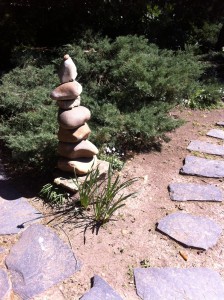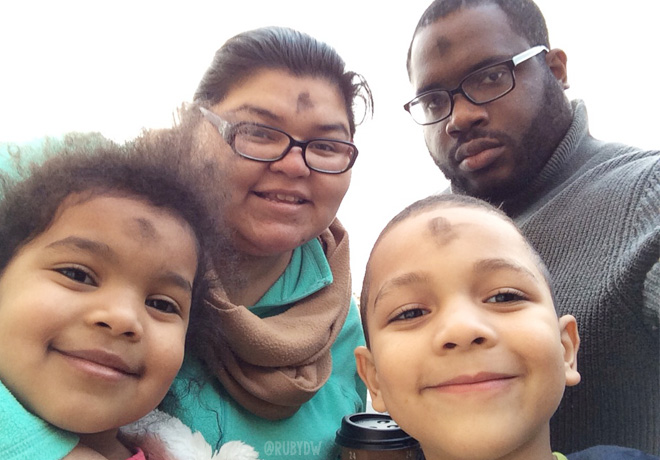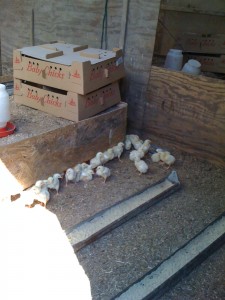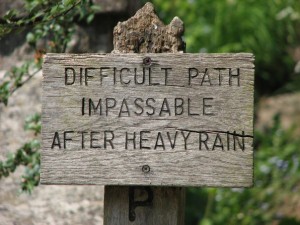
Sermon on Luke 19: 28-40 | Palm Sunday
Here’s the thing about English majors: we believe in metaphors. I don’t just mean we like them or appreciate them. I mean we believe in them. In Franz Kafka’s story, The Metamorphosis, when we read about Gregor Samsa waking up one morning to find that he has transformed into a giant cockroach, we are physically unable to sit back from the story and analyze it “as if” he’s a cockroach. We don’t want to talk about the person who “thinks” he’s a cockroach. We want to go deeper: what does it feel like and how did he know and will his family accept him if he opens his bedroom door? We accept the premise – the metaphor – and everything else follows from there.
Don’t say I didn’t warn you.
When Jesus gets to Jerusalem, the place he’s been headed since the beginning, he sends disciples to procure a colt. He rides the colt into town, amidst a throng of cheering, palm branch-waving people. The crowd is throwing down cloaks on the road for his colt to walk on. The excitement builds and the crowd starts shouting out about the miracles and wonders they have seen. They reach back to the Psalms to praise him, saying, “Blessed is the king who comes in the name of the Lord!” (Luke 19: 38; Psalm 118: 26).
I imagine this scene as just shy of chaos. The full press of crowds, the inner circle of disciples thrilled with the reception, thinking they are finally all getting the recognition they deserve, people shouting over top of one another, palm branches swaying and sometimes smacking people in the face. I hear individual shouts that finally come together into this recognizable praise: “Blessed is the king who comes in the name of the Lord! Peace in heaven, and glory in the highest heaven!” (Luke 19: 38). Everyone chanting this familiar poetry together in one booming voice.
It’s making the Pharisees nervous and a few of them get close enough to speak to Jesus over the roar. They say, with concerned looks on their faces, Rabbi, you’d better tell them to stop. This is getting out of hand here. Please have them quiet down (v. 39).
And Jesus responds, “I tell you, if these [people] were silent, the stones would shout out” (Luke 19: 40). In other words, Even if I shushed them and they all fell silent, these stones here on the path would shout out in their place. Those stone arches into the city would shout praises. The stones would take their place and continue the chorus.
He doesn’t say The crowd’s too big and I’ll never quiet them down. He doesn’t say Who them? But they are praising me and it sounds so gooood. He doesn’t say anything about whether he could or would quiet them; he simply says that someone else would speak up. The stones would cry out.
Ah, metaphor! What is Jesus trying to say by invoking the stones here?
What would that sound like? Do they all know Psalm 118? Would we recognize the words? Would it sound beautiful and scary to us, the way the crowds sounded to those Pharisees?
Since our earliest days as Christians, Lent has been a time of preparation, of being intentionally formed into more faithful disciples. Easter was originally when we baptized new members into the body of Christ and in the very beginning that was after 3 years of preparation. One of our United Methodist liturgical scholars called Lent of year 3 “the home stretch” – after “three years of learning how to pray, how to listen to and learn from scripture, how to care for the poor, the sick, and the orphans, how to care for and advocate for the needs of older persons, and how to overcome addictive patterns in their lives…” (Taylor Burton-Edwards, 3/20/13). Maybe some of you working on 4-year degrees can relate a bit to that kind of a home stretch. It’s a long time to be focused on one life-changing goal. It’s a long time to submit yourself to transformation and refining.
Some things take a long time and it’s hard to see what has happened until later. Like becoming less human one moment at a time until you wake up and find you are a cockroach. Or becoming more Christ-like one prayer at a time, one verse at a time, one relationship at a time, one visited prisoner at a time… Some things take a long time. Like water dripping onto stone, wearing it away drop by drop over hundreds and thousands of years.
Or like stones being formed in the first place.
One of my favorite songs is by Beth Nielsen Chapman and it’s called “Sand and Water.” It’s from her album of the same name, written in her grief after her husband died way too young. Her voice is a little shaky and vulnerable as she describes the shifting sands of life after his death, the crashing waves of grief, the difficulty in finding a solid place to land or stand. But the chorus goes like this: “Solid stone is just sand and water…and a million years gone by.” Some things take a long time, maybe even a million years.
Maybe the stones know something we don’t.
It’s interesting to me that the stones are quiet in this story. Jesus warns that if the people are hushed the stones will speak up. That would imply that they are fully able to speak up and ready to praise. Are they waiting for that moment, then? Do they hear that the people have it covered so they’re just lying low for now? I find myself thinking Hey, stones, Jesus is only coming by this way once, so if you’re going to join in the praises, you’d better pipe up. But when it takes “a million years gone by” to exist, perhaps your perspective isn’t human. Perhaps you have patience and vision that we humans don’t have access to yet.
One of my favorite writers is Annie Dillard and one of my favorite essays of hers is called “Teaching a Stone to Talk,” in a book by the same name (pp.67-76). Annie Dillard is a novelist, essayist, professor, nature-lover, and friend of God. In “Teaching a Stone to Talk” she tells the story of a man she once knew named Larry who was, truly, attempting to teach a stone to talk. Dillard commends Larry in this, his life’s work recognizing his sacrifice and devotion, recognizing how much we long to hear from the rest of creation and how much we doubt that anything is being said.
She writes:
It is difficult to undo our own damage, and to recall to our presence that which we have asked to leave. It is hard to desecrate a grove and change your mind. The very holy mountains are keeping mum. We doused the burning bush and cannot rekindle it; we are lighting matches in vain under every green tree. Did the wind used to cry, and the hills shout forth praise? Now speech has perished from among the lifeless things of earth, and living things say very little to very few. Birds may crank out sweet gibberish and monkeys howl; horses neigh and pigs say, as you recall, oink, oink. But so do cobbles rumble when a wave recedes, and thunders break the air in lightning storms. I call these noises silence. It could be that wherever there is motion there is noise, as when a whale breaches and smacks the water – and wherever there is stillness there is the still small voice, God’s speaking from the whirlwind, nature’s old song and dance, the show we drove from town. …At a certain point you say to the woods, to the sea, to the mountains, the world, Now I am ready. Now I will stop and be wholly attentive. You empty yourself and wait, listening…We are here to witness…
I don’t know if Jesus meant that the stones would literally shout out praises or not. But I believe he meant what he said. I believe he meant that we aren’t the only ones who recognize the presence of God. Surely these stones would cry out. All of creation is part of this story and – silent or not – all of creation witnesses and praises along with us. If need be, instead of us.
The arc of God’s story arc is long and we are somewhere in the middle of it all, thinking that 3 years is a long time to wait to be baptized. We aren’t the first, we won’t be the last, and we aren’t the only ones right now. The stones may be silent but they are biding their time. Jesus is passing by today, on his way to scarier territory this week. It’ll be tempting to stand here full of praise and then to stay here empty-handed, remembering the parade. Don’t.
Follow where he goes, praising, silent, faithful. Trust that the journey is longer than you know or think you can stand. Keep following. Trust that out of simple things like sand and water, God can make stone. Out of a simple thing like dust, God makes you. Submit yourself to transformation and refining, to the stony path of discipleship. Know that whatever you did or didn’t do for Lent is one drop on the hard surface of your heart. There will be others. And know that you have all the time in the world to cry out in praise.
Thanks be to God!







 Sermon on Luke 13: 1-9 | 3 March 2013 – Lent 3
Sermon on Luke 13: 1-9 | 3 March 2013 – Lent 3
 Sermon on Luke 13: 31-35 | 24 February 2013 – Lent 2
Sermon on Luke 13: 31-35 | 24 February 2013 – Lent 2
 ad of offering a way to focus our habits and appetites on God, it feels like another thing added to the dreaded to do (or to not do) list. It can feel distinctly un-faithful.
ad of offering a way to focus our habits and appetites on God, it feels like another thing added to the dreaded to do (or to not do) list. It can feel distinctly un-faithful. I traveled solo for a long time. Single, with friends and family all over the globe and a love of the road, meant I developed habits to keep me safe, on schedule, traveling light, and unnoticed.
I traveled solo for a long time. Single, with friends and family all over the globe and a love of the road, meant I developed habits to keep me safe, on schedule, traveling light, and unnoticed. I’ve been thinking about Ash Wednesday a little differently this year as I’ve worked on the liturgy and prepared myself to say to people, one after the other, “Remember you are dust, and to dust you shall return.” I blame it on the pottery classes I’ve been taking.
I’ve been thinking about Ash Wednesday a little differently this year as I’ve worked on the liturgy and prepared myself to say to people, one after the other, “Remember you are dust, and to dust you shall return.” I blame it on the pottery classes I’ve been taking.